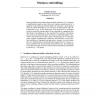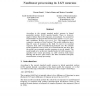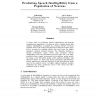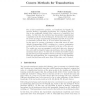NIPS
2003
14 years 2 months ago
2003
Spectral methods for nonlinear dimensionality reduction (NLDR) impose a neighborhood graph on point data and compute eigenfunctions of a quadratic form generated from the graph. W...
NIPS
2003
14 years 2 months ago
2003
We address in this paper the question of how the knowledge of the marginal distribution P(x) can be incorporated in a learning algorithm. We suggest three theoretical methods for ...
NIPS
2003
14 years 2 months ago
2003
We consider situations where training data is abundant and computing resources are comparatively scarce. We argue that suitably designed online learning algorithms asymptotically ...
NIPS
2003
14 years 2 months ago
2003
A novel algorithm for actively trading stocks is presented. While traditional universal algorithms (and technical trading heuristics) attempt to predict winners or trends, our app...
NIPS
2003
14 years 2 months ago
2003
According to the current standard model, neurons in lateral geniculate nucleus (LGN) operate linearly. There is, however, ample evidence that LGN responses are nonlinear. To accou...
NIPS
2003
14 years 2 months ago
2003
A major issue in evaluating speech enhancement and hearing compensation algorithms is to come up with a suitable metric that predicts intelligibility as judged by a human listener...
NIPS
2003
14 years 2 months ago
2003
We present test results from spike-timing correlation learning experiments carried out with silicon neurons with STDP (Spike Timing Dependent Plasticity) synapses. The weight chan...
NIPS
2003
14 years 2 months ago
2003
We address the problem of learning topic hierarchies from data. The model selection problem in this domain is daunting—which of the large collection of possible trees to use? We...
NIPS
2003
14 years 2 months ago
2003
Psychophysical studies suggest the existence of specialized detectors for component motion patterns (radial, circular, and spiral), that are consistent with the visual motion prop...
NIPS
2003
14 years 2 months ago
2003
The 2-class transduction problem, as formulated by Vapnik [1], involves finding a separating hyperplane for a labelled data set that is also maximally distant from a given set of...




